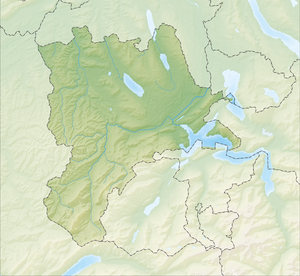Lunch
| Lunch | ||
|---|---|---|
|
Mittaggüpfi (right summit) and Stäfeliflue (left summit), in front Oberalp with the former Pilatussee |
||
| height | 1916.6 m above sea level M. | |
| location | Kantonsgrenze Canton Lucerne / Obwalden , Switzerland . | |
| Mountains | Pilatus massif | |
| Dominance | 1.9 km → Stäfeliflue | |
| Notch height | 154 m ↓ Wängengrat | |
| Coordinates | 656 986 / 202560 | |
|
|
||
The Mittaggüpfi ( 1916.6 m above sea level , also Gnepfstein or Gnapfstein ) is a summit of the Pilatus massif in the Central Swiss Pre-Alps , or the Lucerne Pre-Alps on the canton border between Obwalden and Lucerne , Switzerland .
reachability
The Mittaggüpfi is easily accessible from the south-east ( Lütoldsmatt , 2½ hours), from the north-west (Stäfeli, 1½ hours) and from the north-east ( Eigenhal , approx. 2½ hours). In addition, the summit is a central station on the popular ridge hike from Pilatus Kulm to Stäfeliflue and Risetestock . Since you are mostly on the ridge height on this high path, you have numerous deep views and a comprehensive view of the Swiss plateau and the Alps . In winter, the ascent of the relatively far set summit in the Pilatus chain is often combined with a visit to the Widderfeld (ascent from Alpnach or Lütoldsmatt).
etymology
The name Mittaggüpfi probably originated in the area of the proper valley . Here the summit acts as a midday point , i.e. i.e., it denotes the middle of the daily routine, the time of the midday meal and the direction south.
It used to be called the Mittaggüpfi Oberalpgupf or Gnepfenstein. A so-called Gnappstein ( pierre branlante ) is said to have been located on the top of the hill (gnepfender, gnappender, rocking stone). This is partly associated with a Celtic mountain cult. According to tradition, a lightning bolt split the stone tablet and caused it to fall into the abyss. When Christianity first arrived in the region, the priesthood had a lot to contend with against the indolent pagan customs . It is believed that they connected the legend of Pontius Pilate with the ominous Lake Pilate in order to make the site a place to be strictly avoided. Until 1594 , visiting the Pilatussee and the Mittaggüpfi was forbidden by the authorities.
Another interpretation sees a predecessor of “Napf” in the word “Gnepf, Gnäpf”. Thus, the same conical shapes of the "Gnäpf (rock)", and the nearby mountain cup both the wooden hopper (= well) to the Alpsennen when Betruf as megaphone operate.
geology
The Mittagsgüpfi shows on its northern slope from the subalpine flysch zone (area Trockenmattsattel) a simple sequence of layers, which is structured like a staircase according to the hardness of the rock. The Valangian limestone , here as the oldest layer member, rests on the flysch with a sharp thrust . Above that follows the simple sequence of layers ( Kieselkalk , Drusbergschichten , Schrattenkalk , Eocene formations ) which stretches eastward to the Klimsenhorn . The summit area is built up by the Hohgantsandstein (Eocene). The sequence of layers falls relatively flat towards the south and shows slight folds, e.g. T associated with fractions. The southern chain of the Pilatus massif (Matthorn vault) emerges from the southernmost fold (Längenschwandgrat: Hohgantsandstein) to the east . Finally, to the south, the mighty Schlierenflysch mass lies on the town slate.
literature
- A. Buxtorf: Geology of Pilatus, lecture given at the 105th annual meeting of the Swiss Natural Research Society in Lucerne on October 1, 1924 , Buchdruckerei Büchler & Co., Bern 1924
- Alfred Helfenstein: The name of the Pilatus area , Keller & Co AG, Lucerne 1982, ISBN 3-85766-004-X
- Hugo Nünlist : Pilatus and its secrets , Sauerländer and Co, Aarau o. J.
- Bernhard Zimmermann: Pilatus - the world-famous mountain in Switzerland , Alpnachstad 1949
- Hans Pfister: Pilatus, Legends and Stories , Verlag Eugen Haag, Lucerne 1991
- Peter Xaver Weber: The Pilatus and its history , Eugen Haag publishing house, Lucerne 1913

